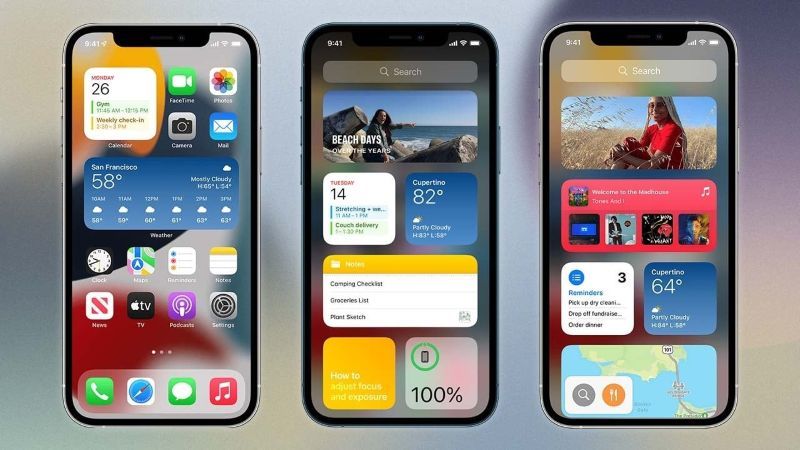

iOS widgets have revolutionized the way we interact with our iPhones, offering quick access to information and functionality right from the home screen. Let's explore this topic in more detail with Tiny Fishing below, as we delve into the world of iOS widgets and discover how to customize your home screen like a pro. Whether you're a young user, office worker, technology enthusiast, or a long-time iPhone user looking to make the most of your device, this comprehensive guide will help you unlock the full potential of iOS widgets and transform your iPhone experience.
iOS widgets are miniature versions of apps that display dynamic information or provide quick access to specific features without the need to open the full application. These powerful tools were introduced with iOS 14 and have since become an integral part of the iPhone user experience. Widgets come in various sizes and can be placed directly on your home screen, allowing for unprecedented customization and functionality.
One of the key advantages of widgets is their ability to provide at-a-glance information, saving you time and taps. For instance, a weather widget can show you the current temperature and forecast without opening the Weather app, while a calendar widget can display your upcoming events right on your home screen. This instant access to information is particularly valuable for busy professionals and students who need to stay on top of their schedules and tasks.
Moreover, widgets can significantly enhance your productivity by offering quick actions. For example, a notes widget might allow you to jot down a quick thought or create a new to-do item with just a tap. This seamless integration of app functionality into your home screen can streamline your workflow and help you make the most of your iPhone's capabilities.
Read more: Best Features in iOS You May Have Missed
Now that we understand the basics of iOS widgets, let's dive into the process of customizing your home screen to create a personalized and efficient setup. The key to mastering widget customization lies in understanding the available options and experimenting with different layouts to find what works best for you.
To add a widget to your home screen, simply long-press on an empty area of the screen until the apps start jiggling. Then, tap the "+" icon in the top-left corner to open the widget gallery. Here, you'll find a wide array of widgets from both Apple's built-in apps and third-party applications. Browse through the options and select the widget that suits your needs.
Once you've chosen a widget, you can often select from multiple sizes - small, medium, or large - depending on how much information you want to display and how much screen real estate you're willing to dedicate. Consider the balance between information density and visual appeal when making your selection. A larger widget might provide more detailed information, but it will also take up more space on your home screen.
After adding a widget, you can further customize it by long-pressing on the widget and selecting "Edit Widget." This allows you to tailor the widget's content and appearance to your preferences. For instance, you might choose which calendar to display in a calendar widget or select specific stocks to track in a finance widget.
One of the most powerful features of iOS widgets is the ability to create widget stacks. A stack allows you to group multiple widgets of the same size into a single space on your home screen. You can then swipe through the stack to access different widgets quickly. This feature is particularly useful for maximizing screen real estate while still having access to a variety of information.
To create a widget stack, simply drag one widget on top of another of the same size. You can continue adding widgets to the stack as desired. Once your stack is created, you can customize its behavior by long-pressing on the stack and selecting "Edit Stack." Here, you can reorder the widgets within the stack and toggle on "Smart Rotate," which allows iOS to automatically show you the most relevant widget based on your usage patterns and the time of day.
Widgets aren't just about aesthetics; they can significantly boost your productivity and help you make the most of your iPhone. By strategically selecting and arranging widgets, you can create a home screen that serves as a powerful command center for your daily tasks and information needs.
For professionals and students, consider adding widgets that provide quick access to your most-used productivity tools. A calendar widget can give you an instant overview of your day's schedule, while a reminders widget can help you stay on top of important tasks. If you frequently use note-taking apps, a notes widget can allow you to capture ideas or create to-do items with minimal friction.
For those who rely heavily on communication, widgets for messaging apps or email can provide instant access to recent conversations or important messages. This can be particularly useful for staying connected with colleagues or clients without constantly opening full apps.
Fitness enthusiasts can benefit from widgets that display activity data, workout summaries, or quick access to fitness tracking features. Having this information readily available can serve as a constant reminder and motivation to stay active throughout the day.
Beyond productivity, widgets can serve as invaluable sources of quick information. News widgets can keep you updated on the latest headlines, while weather widgets provide instant access to current conditions and forecasts. For those who travel frequently or rely on public transportation, widgets displaying flight information or transit schedules can be incredibly useful.
Financial widgets can give you a quick overview of your accounts, stock performance, or currency exchange rates. This can be particularly valuable for investors or those who need to keep a close eye on their finances.
For music lovers, audio app widgets can display currently playing tracks and offer quick controls, allowing you to manage your listening experience without opening the full app. This seamless integration of media controls into your home screen can enhance your overall iPhone experience.
Read more: How to Use iPhone Focus Mode to Stay Productive
As you become more comfortable with iOS widgets, you can explore some advanced techniques to further customize your home screen and enhance your iPhone's functionality. These tips and tricks can help you create a truly unique and efficient setup tailored to your specific needs and preferences.
One powerful technique is to use color coordination and theming to create a visually cohesive home screen. Many widget apps offer customization options that allow you to change colors, fonts, and styles. By selecting a consistent color scheme or theme across your widgets and app icons, you can create a stunning and professional-looking home screen that reflects your personal style.
Another advanced tip is to take advantage of third-party widget creation tools. Apps like Widgetsmith and Color Widgets allow you to create custom widgets with a high degree of flexibility. You can design widgets that display exactly the information you want, in the style you prefer. This level of customization can help you create a truly unique home screen that perfectly suits your needs.
While widgets can greatly enhance your iPhone experience, it's important to be mindful of their impact on battery life and performance. Each widget requires some system resources to update and display information. If you find that your battery is draining more quickly than usual or your device seems sluggish, consider reducing the number of widgets or adjusting their update frequency.
To optimize widget performance, review the settings for each widget and adjust the update frequency to balance between timely information and battery conservation. For widgets that don't require constant updates, such as those displaying static information or infrequently changing data, you can often reduce the update frequency without sacrificing functionality.
Additionally, be selective about which widgets you place on your home screen versus those you keep in the Today View (accessible by swiping right from the first home screen or lock screen). Widgets in the Today View tend to use fewer resources, as they're not constantly visible.
iOS widgets have transformed the way we interact with our iPhones, offering unprecedented levels of customization and functionality. By understanding the basics of widgets, learning how to customize your home screen, and leveraging widgets for productivity and quick information access, you can create a truly personalized and efficient iPhone experience.
Remember that the key to mastering iOS widgets is experimentation and iteration. Don't be afraid to try different widget combinations, layouts, and customization options. Your needs and preferences may change over time, so periodically reassess your widget setup to ensure it continues to serve you effectively.
As Apple continues to refine and expand the capabilities of iOS widgets, stay informed about new features and possibilities. Each iOS update may bring new widget options or enhancements, offering fresh opportunities to optimize your home screen.